Baker R.C. Flow Measurement Handbook: Industrial Designs, Operating Principles, Performance, and Applications
Подождите немного. Документ загружается.

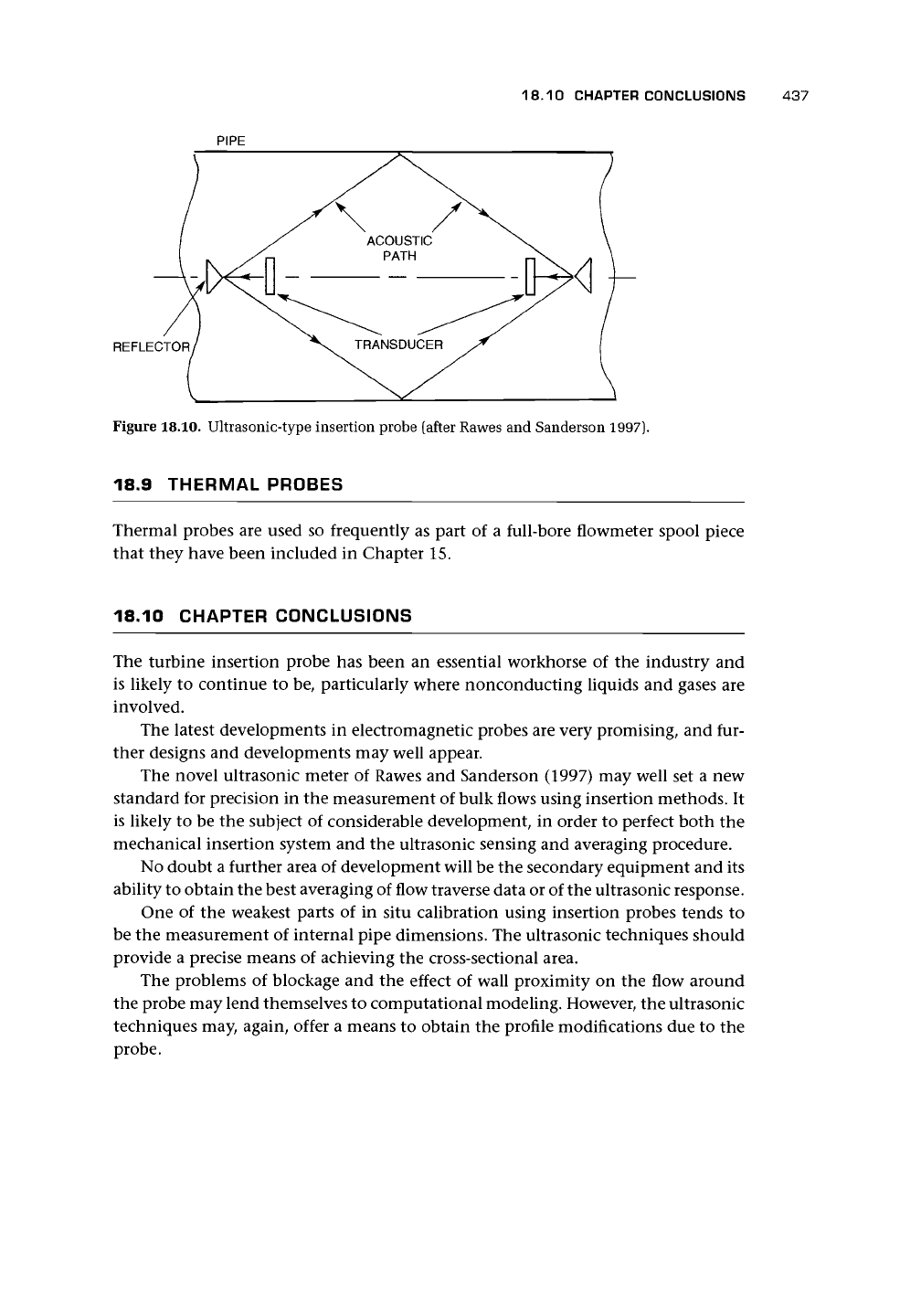
18.10 CHAPTER CONCLUSIONS 437
PIPE
REFLECTOR
Figure 18.10. Ultrasonic-type insertion probe (after Rawes and Sanderson 1997).
18.9 THERMAL PROBES
Thermal probes are used so frequently as part of a full-bore flowmeter spool piece
that they have been included in Chapter 15.
18.10 CHAPTER CONCLUSIONS
The turbine insertion probe has been an essential workhorse of the industry and
is likely to continue to be, particularly where nonconducting liquids and gases are
involved.
The latest developments in electromagnetic probes are very promising, and fur-
ther designs and developments may well appear.
The novel ultrasonic meter of Rawes and Sanderson (1997) may well set a new
standard for precision in the measurement of bulk flows using insertion methods. It
is likely to be the subject of considerable development, in order to perfect both the
mechanical insertion system and the ultrasonic sensing and averaging procedure.
No doubt a further area of development will be the secondary equipment and its
ability to obtain the best averaging of flow traverse data or of the ultrasonic response.
One of the weakest parts of in situ calibration using insertion probes tends to
be the measurement of internal pipe dimensions. The ultrasonic techniques should
provide a precise means of achieving the cross-sectional area.
The problems of blockage and the effect of wall proximity on the flow around
the probe may lend themselves to computational modeling. However, the ultrasonic
techniques may, again, offer a means to obtain the profile modifications due to the
probe.
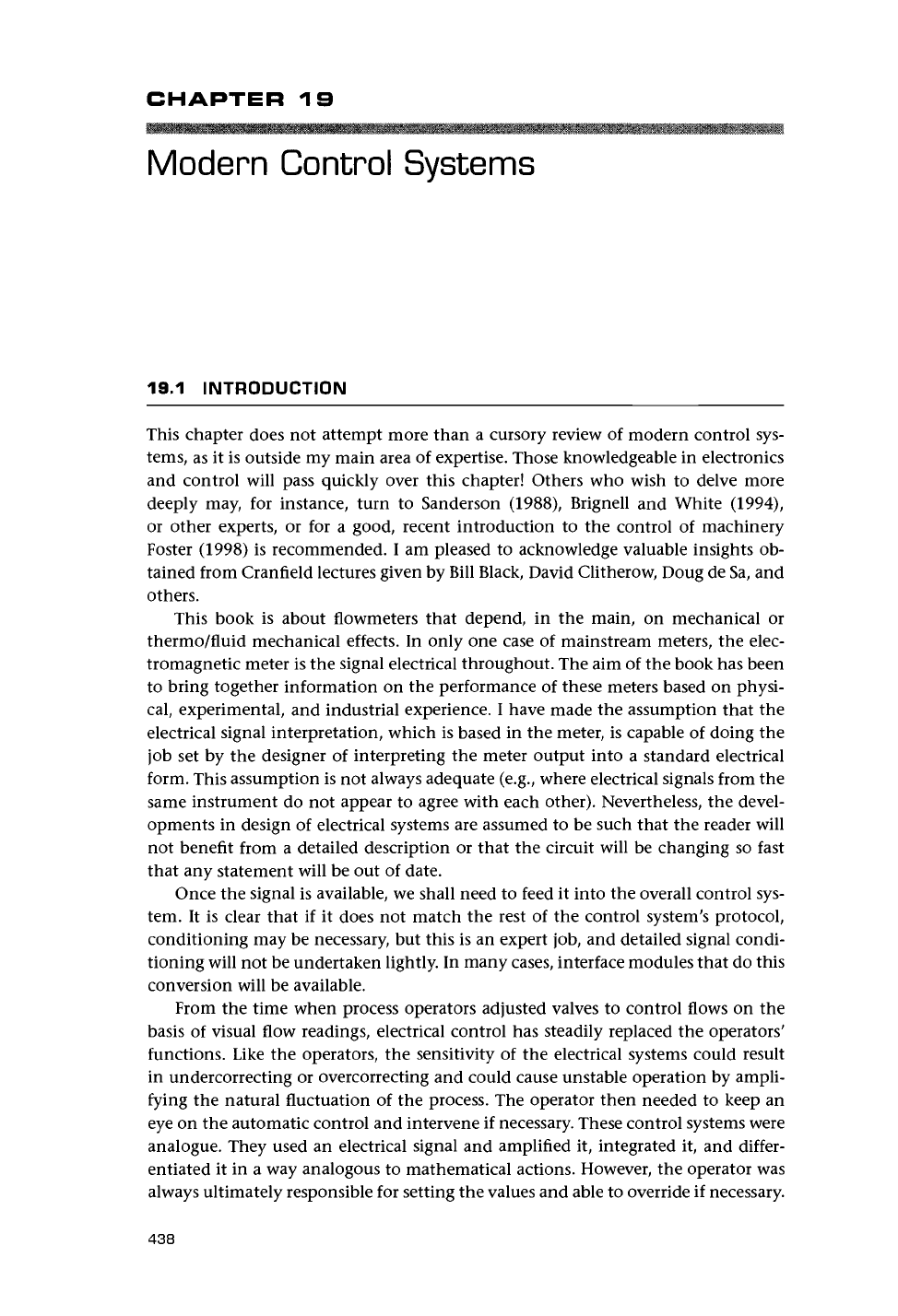
CHAPTER
13
Modern Control Systems
19.1 INTRODUCTION
This chapter does not attempt more than a cursory review of modern control sys-
tems,
as it is outside my main area of expertise. Those knowledgeable in electronics
and control will pass quickly over this chapter! Others who wish to delve more
deeply may, for instance, turn to Sanderson (1988), Brignell and White (1994),
or other experts, or for a good, recent introduction to the control of machinery
Foster (1998) is recommended. I am pleased to acknowledge valuable insights ob-
tained from Cranfield lectures given by Bill Black, David Clitherow, Doug de Sa, and
others.
This book is about flowmeters that depend, in the main, on mechanical or
thermo/fluid mechanical effects. In only one case of mainstream meters, the elec-
tromagnetic meter is the signal electrical throughout. The aim of the book has been
to bring together information on the performance of these meters based on physi-
cal,
experimental, and industrial experience. I have made the assumption that the
electrical signal interpretation, which is based in the meter, is capable of doing the
job set by the designer of interpreting the meter output into a standard electrical
form. This assumption is not always adequate (e.g., where electrical signals from the
same instrument do not appear to agree with each other). Nevertheless, the devel-
opments in design of electrical systems are assumed to be such that the reader will
not benefit from a detailed description or that the circuit will be changing so fast
that any statement will be out of date.
Once the signal is available, we shall need to feed it into the overall control sys-
tem. It is clear that if it does not match the rest of the control system's protocol,
conditioning may be necessary, but this is an expert job, and detailed signal condi-
tioning will not be undertaken lightly. In many
cases,
interface modules that do this
conversion will be available.
From the time when process operators adjusted valves to control flows on the
basis of visual flow readings, electrical control has steadily replaced the operators'
functions. Like the operators, the sensitivity of the electrical systems could result
in undercorrecting or overcorrecting and could cause unstable operation by ampli-
fying the natural fluctuation of the process. The operator then needed to keep an
eye on the automatic control and intervene if necessary. These control systems were
analogue. They used an electrical signal and amplified it, integrated it, and differ-
entiated it in a way analogous to mathematical actions. However, the operator was
always ultimately responsible for setting the values and able to override if necessary.
438
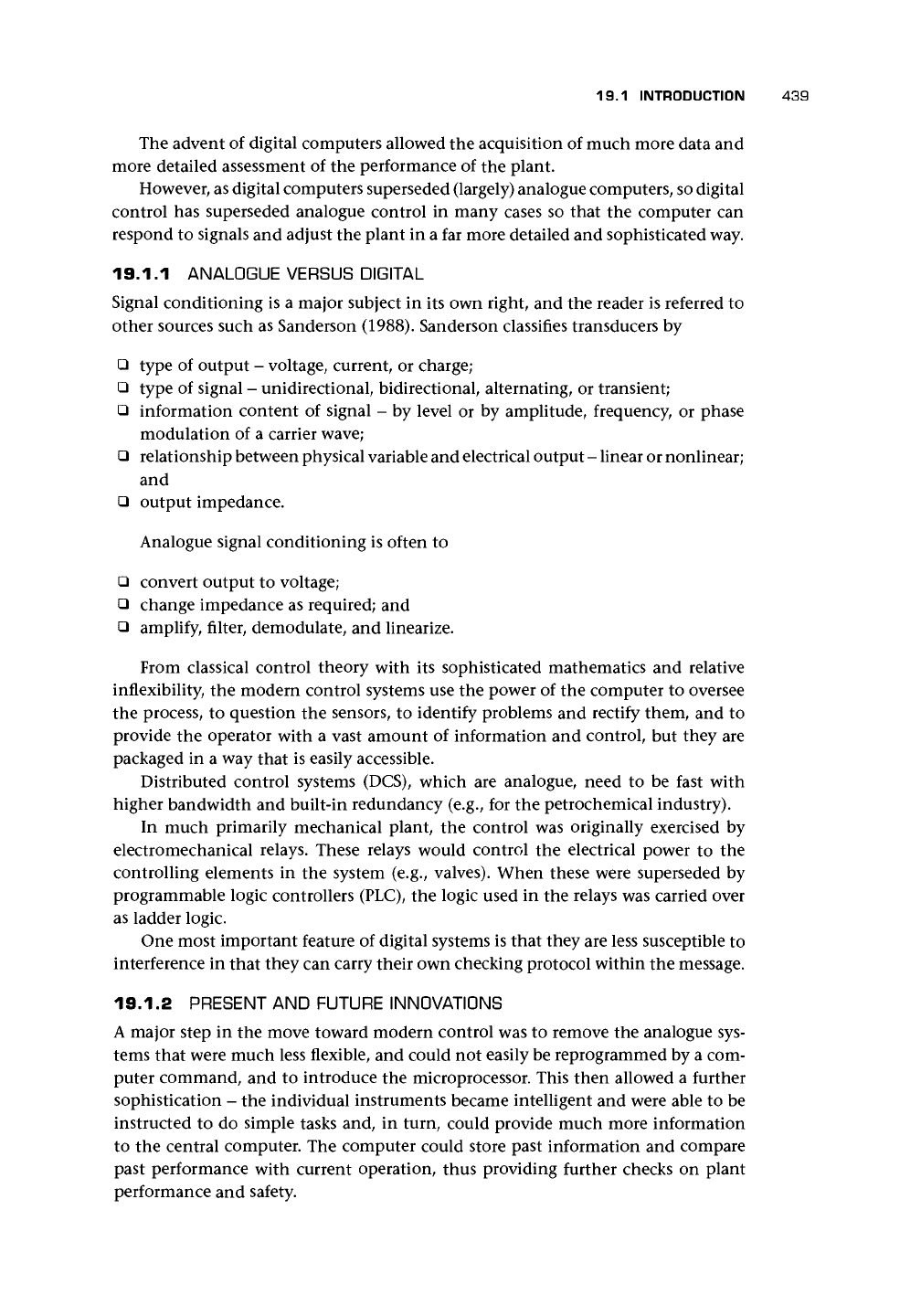
19.1 INTRODUCTION 439
The advent of digital computers allowed the acquisition of much more data and
more detailed assessment of the performance of the plant.
However, as digital computers superseded (largely) analogue computers, so digital
control has superseded analogue control in many cases so that the computer can
respond to signals and adjust the plant in a far more detailed and sophisticated way.
19.1.1 ANALOGUE VERSUS DIGITAL
Signal conditioning is a major subject in its own right, and the reader is referred to
other sources such as Sanderson (1988). Sanderson classifies transducers by
• type of output - voltage, current, or charge;
• type of signal - unidirectional, bidirectional, alternating, or transient;
• information content of signal - by level or by amplitude, frequency, or phase
modulation of a carrier wave;
• relationship between physical variable and electrical output - linear or nonlinear;
and
• output impedance.
Analogue signal conditioning is often to
• convert output to voltage;
• change impedance as required; and
• amplify, filter, demodulate, and linearize.
From classical control theory with its sophisticated mathematics and relative
inflexibility, the modern control systems use the power of the computer to oversee
the process, to question the sensors, to identify problems and rectify them, and to
provide the operator with a vast amount of information and control, but they are
packaged in a way that is easily accessible.
Distributed control systems (DCS), which are analogue, need to be fast with
higher bandwidth and built-in redundancy (e.g., for the petrochemical industry).
In much primarily mechanical plant, the control was originally exercised by
electromechanical relays. These relays would control the electrical power to the
controlling elements in the system (e.g., valves). When these were superseded by
programmable logic controllers (PLC), the logic used in the relays was carried over
as ladder logic.
One most important feature of digital systems is that they are less susceptible to
interference in that they can carry their own checking protocol within the message.
19.1.2 PRESENT AND FUTURE INNOVATIONS
A major step in the move toward modern control was to remove the analogue sys-
tems that were much less flexible, and could not easily be reprogrammed by a com-
puter command, and to introduce the microprocessor. This then allowed a further
sophistication - the individual instruments became intelligent and were able to be
instructed to do simple tasks and, in turn, could provide much more information
to the central computer. The computer could store past information and compare
past performance with current operation, thus providing further checks on plant
performance and safety.

440 MODERN CONTROL SYSTEMS
This led to the idea that the communication system could be a signal highway
(or bus), to which any instrument with the right protocol and any computer could
be connected. The signal highway could be of copper, but equally could be of optical
fiber, electromagnetic waves, or superimposed signals carried by the electricity main
or telephone lines. Transmitters and repeaters could then include satellites, and the
system could be, essentially, unbounded.
At the other end of this communication link is the computer or computers that
control the process and that will be able to work in tandem if necessary, and the plant
operators will work to visual display unit (VDU) screens with the latest windows
presentations and graphical portrayal of each part and aspect of the plant and its
operation.
All this requires a generally accepted common communication language or pro-
tocol to which instruments and systems conform and that will ensure each message
is correctly sent and received, without interference.
Modern telemetry systems provide the means of controlling plant and measuring
its performance from a central station. The three aspects of the process are
• the measurement technology, which has been the prime subject of this book. The
microcomputer has revolutionized this technology with smart and intelligent
instrumentation. One aspect that may need attention is signal conditioning.
The signal from a sensor may not be suitable for a system and may need to be
adapted: from analogue to digital, from digital to analogue, or other change.
• the method of transmission, which, having been by means of copper wires for
much of its history to the present, is now the subject of continual and highly
sophisticated alternative developments.
• the controls, both instrument outputs and process adjustment means. From di-
rect, but remote, control of instruments, through analogue computers, this has
now firmly arrived at digital computer techniques.
19.1.3 INDUSTRIAL IMPLICATIONS
The range of industries is now very wide and includes water and sewage treatment
and distribution, oil and gas production and pipelines, process industries of all sorts,
and manufacturing including the production of flowmeters. The techniques are, of
course, not limited to process flow but can also be used in the electricity genera-
tion and distribution industry, the electrical power transmission industries (e.g., rail
networks), building services, and lighting control.
This means that the typical company supplying such equipment and systems
is increasingly a software-based company, using proprietary equipment and supply-
ing the software for the control station and the outstations, and using whichever
transmission system is most appropriate to the task and the customer's needs.
19.1.4 CHAPTER OUTLINE
This chapter provides an overview of how the signals from these meters are used in
the control of
plant.
In referring to meter or flowmeter, the reader should understand
that broadly the same will be true of other instruments within the system. I shall
start from the assumption that, despite increasing coordination between signal spec-
ifications (protocols), there is still sufficient variation to make it impossible to use
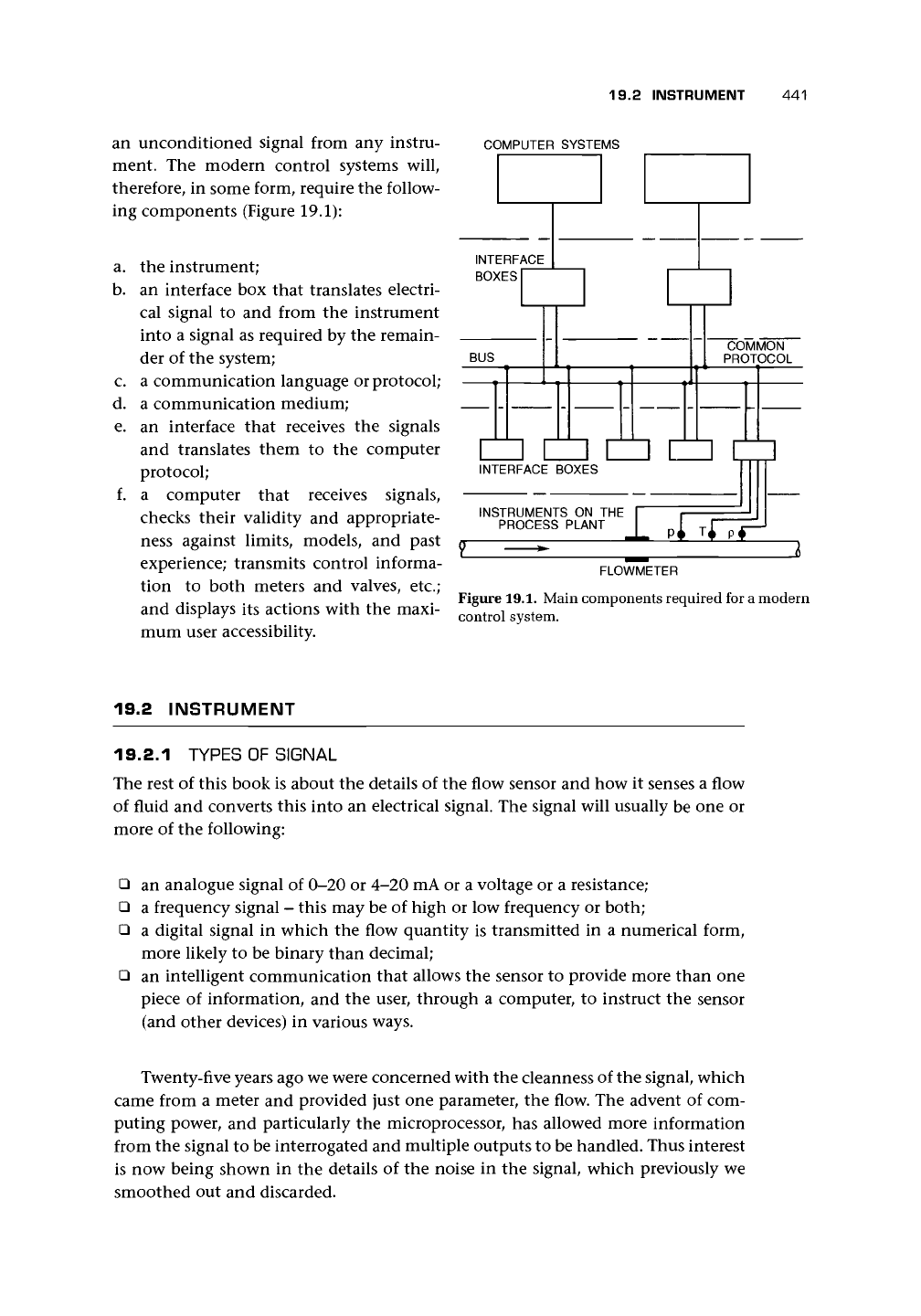
19.2 INSTRUMENT
441
an unconditioned signal from any instru-
ment. The modern control systems will,
therefore, in some form, require the follow-
ing components (Figure 19.1):
a. the instrument;
b.
an interface box that translates electri-
cal signal to and from the instrument
into a signal as required by the remain-
der of the system;
c. a communication language or protocol;
d. a communication medium;
e. an interface that receives the signals
and translates them to the computer
protocol;
f. a computer that receives signals,
checks their validity and appropriate-
ness against limits, models, and past
experience; transmits control informa-
tion to both meters and valves, etc.;
and displays its actions with the maxi-
mum user accessibility.
COMPUTER SYSTEMS
INTERFACE
BOXES
BUS
INTERFACE BOXES
COMMON
PROTOCOL
INSTRUMENTS ON THE
PROCESS PLANT
FLOWMETER
Figure 19.1. Main components required for a modern
control system.
19.2 INSTRUMENT
19.2.1 TYPES OF SIGNAL
The rest of this book is about the details of the flow sensor and how it senses a flow
of fluid and converts this into an electrical signal. The signal will usually be one or
more of the following:
• an analogue signal of 0-20 or 4-20 mA or a voltage or a resistance;
• a frequency signal - this may be of high or low frequency or both;
• a digital signal in which the flow quantity is transmitted in a numerical form,
more likely to be binary than decimal;
• an intelligent communication that allows the sensor to provide more than one
piece of information, and the user, through a computer, to instruct the sensor
(and other devices) in various ways.
Twenty-five years ago we were concerned with the cleanness of the signal, which
came from a meter and provided just one parameter, the flow. The advent of com-
puting power, and particularly the microprocessor, has allowed more information
from the signal to be interrogated and multiple outputs to be handled. Thus interest
is now being shown in the details of the noise in the signal, which previously we
smoothed out and discarded.
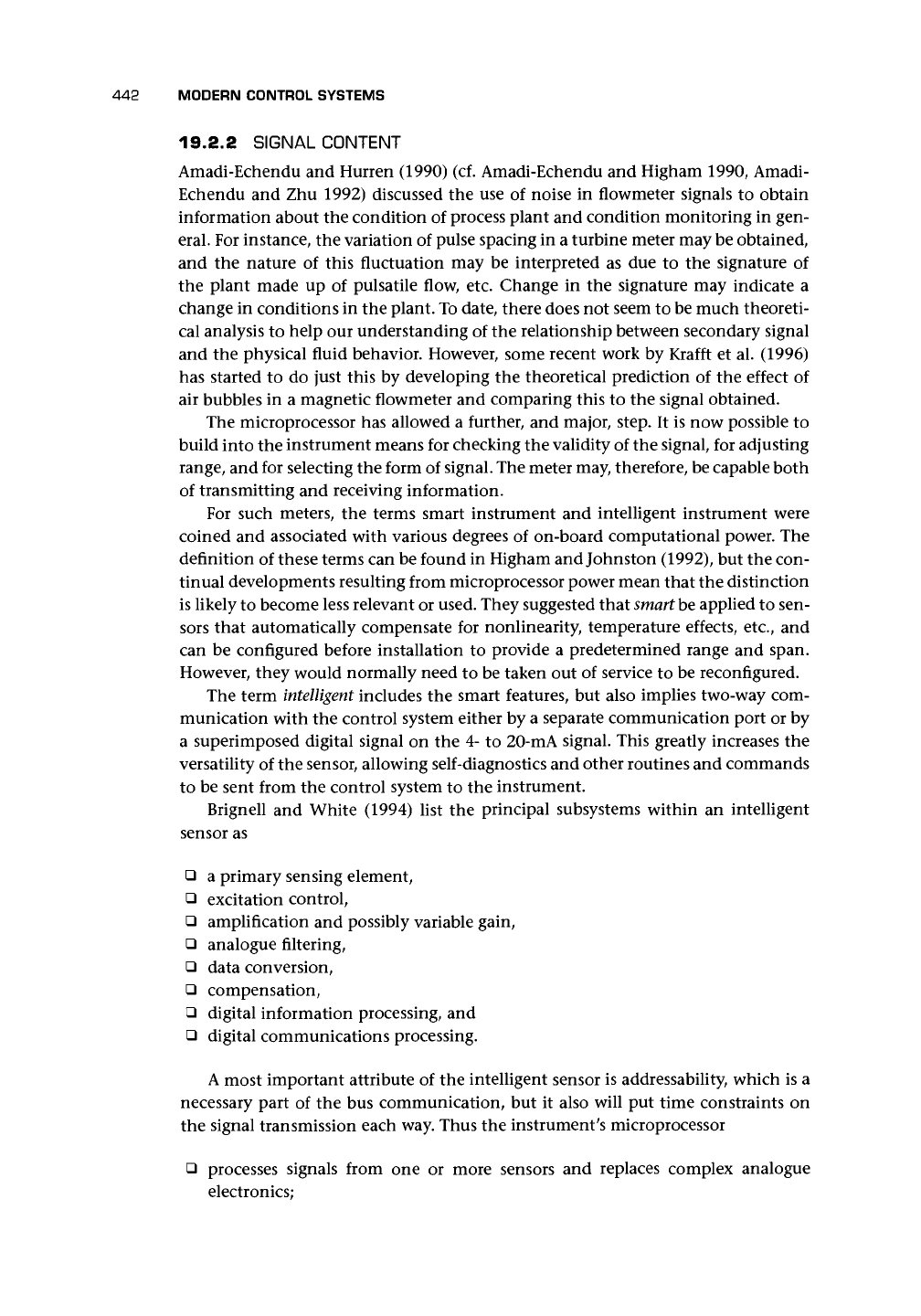
442 MODERN CONTROL SYSTEMS
19.2.2 SIGNAL CONTENT
Amadi-Echendu and Hurren (1990) (cf. Amadi-Echendu and Higham 1990, Amadi-
Echendu and Zhu 1992) discussed the use of noise in flowmeter signals to obtain
information about the condition of process plant and condition monitoring in gen-
eral. For instance, the variation of pulse spacing in a turbine meter may be obtained,
and the nature of this fluctuation may be interpreted as due to the signature of
the plant made up of pulsatile flow, etc. Change in the signature may indicate a
change in conditions in the plant. To date, there does not seem to be much theoreti-
cal analysis to help our understanding of the relationship between secondary signal
and the physical fluid behavior. However, some recent work by Krafft et al. (1996)
has started to do just this by developing the theoretical prediction of the effect of
air bubbles in a magnetic flowmeter and comparing this to the signal obtained.
The microprocessor has allowed a further, and major, step. It is now possible to
build into the instrument means for checking the validity of the signal, for adjusting
range, and for selecting the form of
signal.
The meter may, therefore, be capable both
of transmitting and receiving information.
For such meters, the terms smart instrument and intelligent instrument were
coined and associated with various degrees of on-board computational power. The
definition of these terms can be found in Higham and Johnston (1992), but the con-
tinual developments resulting from microprocessor power mean that the distinction
is likely to become less relevant or used. They suggested that smart be applied to sen-
sors that automatically compensate for nonlinearity, temperature effects, etc., and
can be configured before installation to provide a predetermined range and span.
However, they would normally need to be taken out of service to be reconfigured.
The term
intelligent
includes the smart features, but also implies two-way com-
munication with the control system either by a separate communication port or by
a superimposed digital signal on the 4- to 20-mA signal. This greatly increases the
versatility of the sensor, allowing self-diagnostics and other routines and commands
to be sent from the control system to the instrument.
Brignell and White (1994) list the principal subsystems within an intelligent
sensor as
• a primary sensing element,
• excitation control,
• amplification and possibly variable gain,
• analogue filtering,
• data conversion,
• compensation,
• digital information processing, and
• digital communications processing.
A most important attribute of the intelligent sensor is addressability, which is a
necessary part of the bus communication, but it also will put time constraints on
the signal transmission each way. Thus the instrument's microprocessor
• processes signals from one or more sensors and replaces complex analogue
electronics;
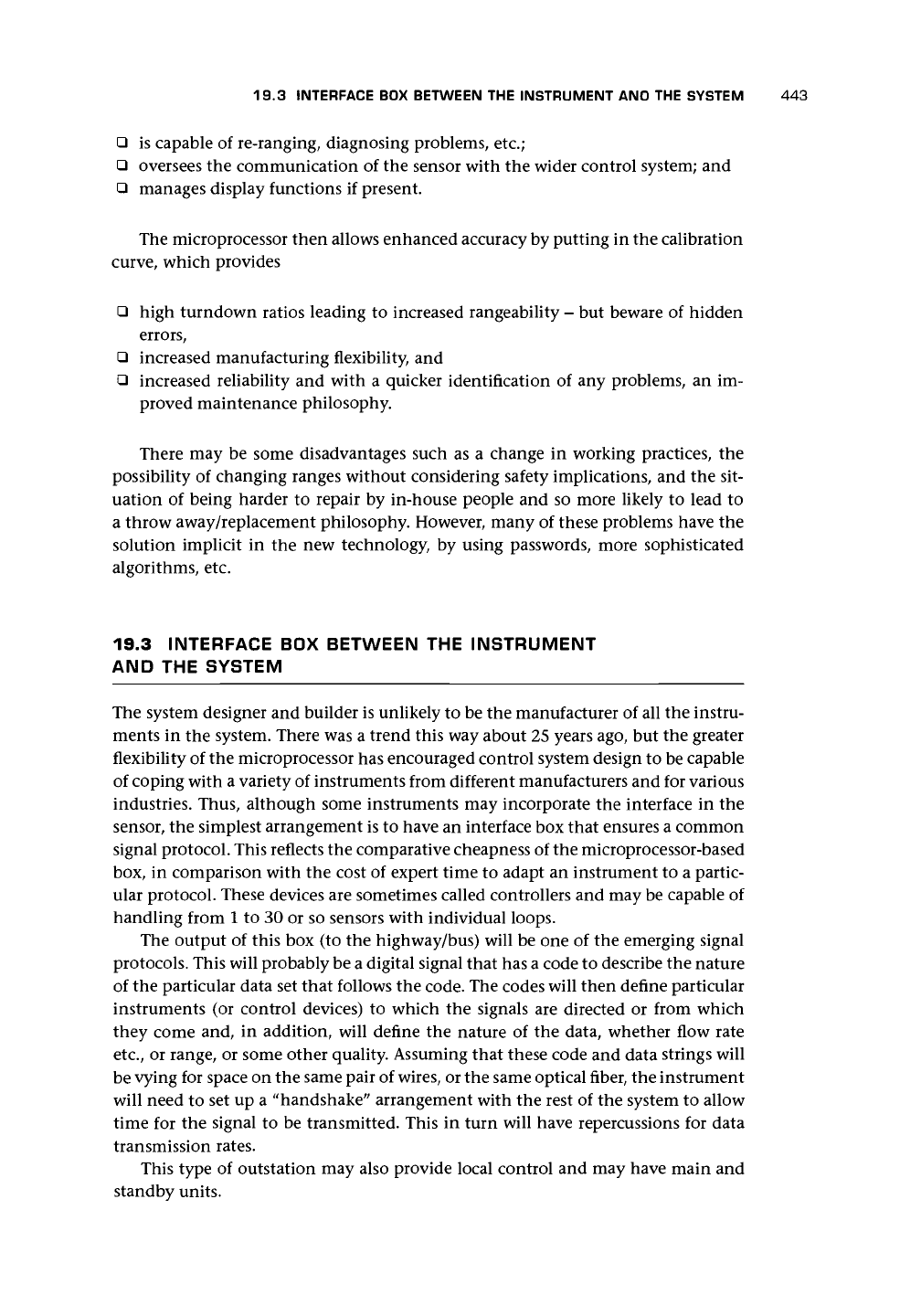
19.3 INTERFACE BOX BETWEEN THE INSTRUMENT AND THE SYSTEM 443
• is capable of re-ranging, diagnosing problems, etc.;
• oversees the communication of the sensor with the wider control system; and
• manages display functions if present.
The microprocessor then allows enhanced accuracy by putting in the calibration
curve, which provides
• high turndown ratios leading to increased rangeability - but beware of hidden
errors,
• increased manufacturing flexibility, and
• increased reliability and with a quicker identification of any problems, an im-
proved maintenance philosophy.
There may be some disadvantages such as a change in working practices, the
possibility of changing ranges without considering safety implications, and the sit-
uation of being harder to repair by in-house people and so more likely to lead to
a throw away/replacement philosophy. However, many of these problems have the
solution implicit in the new technology, by using passwords, more sophisticated
algorithms, etc.
19.3 INTERFACE BOX BETWEEN THE INSTRUMENT
AND THE SYSTEM
The system designer and builder is unlikely to be the manufacturer of all the instru-
ments in the system. There was a trend this way about 25 years ago, but the greater
flexibility of the microprocessor has encouraged control system design to be capable
of coping with a variety of instruments from different manufacturers and for various
industries. Thus, although some instruments may incorporate the interface in the
sensor, the simplest arrangement is to have an interface box that ensures a common
signal protocol. This reflects the comparative cheapness of the microprocessor-based
box, in comparison with the cost of expert time to adapt an instrument to a partic-
ular protocol. These devices are sometimes called controllers and may be capable of
handling from 1 to 30 or so sensors with individual loops.
The output of this box (to the highway/bus) will be one of the emerging signal
protocols. This will probably be a digital signal that has a code to describe the nature
of the particular data set that follows the code. The codes will then define particular
instruments (or control devices) to which the signals are directed or from which
they come and, in addition, will define the nature of the data, whether flow rate
etc.,
or range, or some other quality. Assuming that these code and data strings will
be vying for space on the same pair of
wires,
or the same optical fiber, the instrument
will need to set up a "handshake" arrangement with the rest of the system to allow
time for the signal to be transmitted. This in turn will have repercussions for data
transmission rates.
This type of outstation may also provide local control and may have main and
standby units.
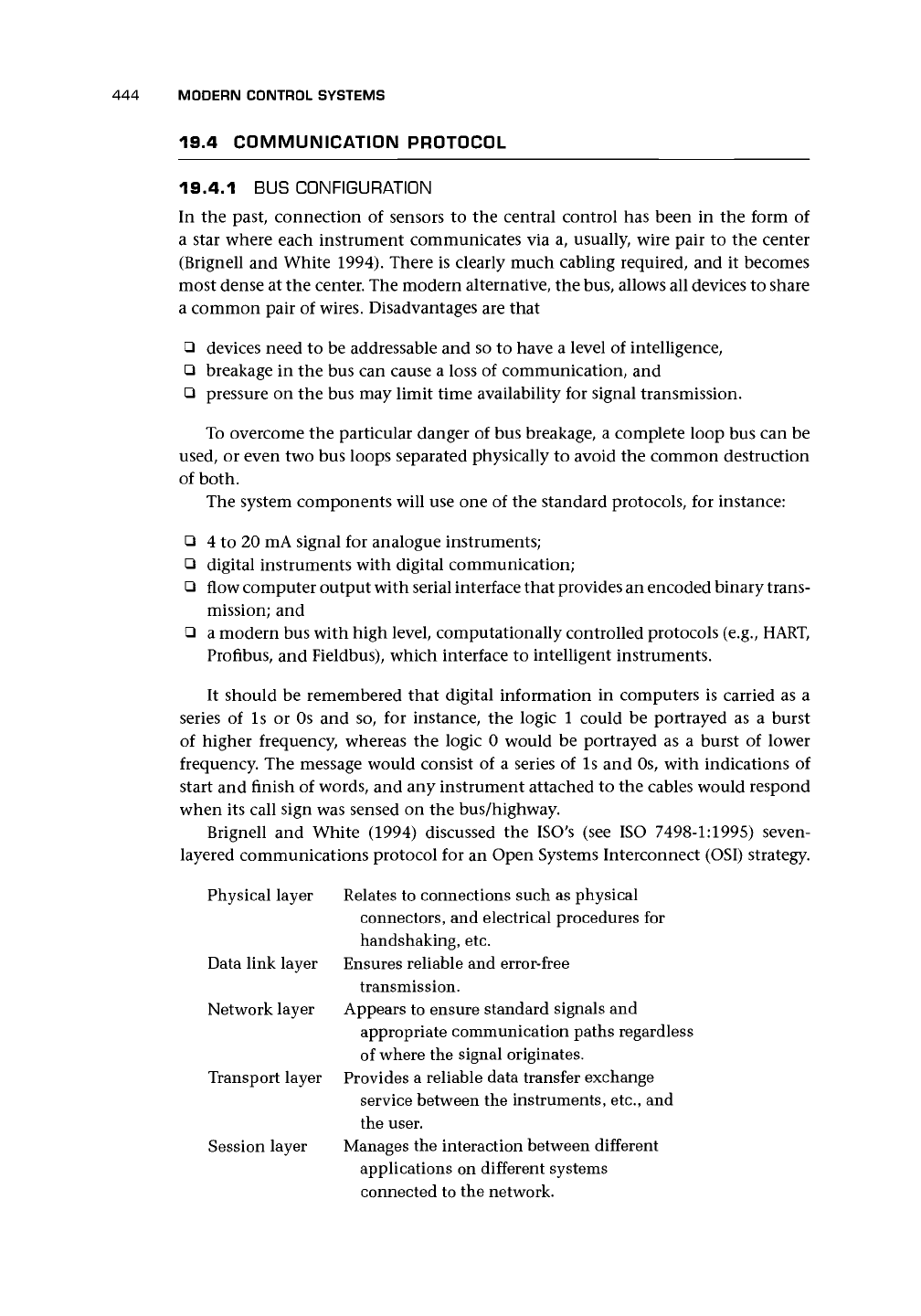
444 MODERN CONTROL SYSTEMS
19.4 COMMUNICATION PROTOCOL
19.4.1 BUS CONFIGURATION
In the past, connection of sensors to the central control has been in the form of
a star where each instrument communicates via a, usually, wire pair to the center
(Brignell and White 1994). There is clearly much cabling required, and it becomes
most dense at the center. The modern alternative, the bus, allows all devices to share
a common pair of wires. Disadvantages are that
• devices need to be addressable and so to have a level of intelligence,
• breakage in the bus can cause a loss of communication, and
• pressure on the bus may limit time availability for signal transmission.
To overcome the particular danger of bus breakage, a complete loop bus can be
used, or even two bus loops separated physically to avoid the common destruction
of both.
The system components will use one of the standard protocols, for instance:
• 4 to 20 mA signal for analogue instruments;
• digital instruments with digital communication;
• flow computer output with serial interface that provides an encoded binary trans-
mission; and
• a modern bus with high level, computationally controlled protocols (e.g., HART,
Profibus, and Fieldbus), which interface to intelligent instruments.
It should be remembered that digital information in computers is carried as a
series of Is or 0s and so, for instance, the logic 1 could be portrayed as a burst
of higher frequency, whereas the logic 0 would be portrayed as a burst of lower
frequency. The message would consist of a series of Is and 0s, with indications of
start and finish of words, and any instrument attached to the cables would respond
when its call sign was sensed on the bus/highway.
Brignell and White (1994) discussed the ISO's (see ISO 7498-1:1995) seven-
layered communications protocol for an Open Systems Interconnect (OSI) strategy.
Physical layer Relates to connections such as physical
connectors, and electrical procedures for
handshaking, etc.
Data link layer Ensures reliable and error-free
transmission.
Network layer Appears to ensure standard signals and
appropriate communication paths regardless
of where the signal originates.
Transport layer Provides a reliable data transfer exchange
service between the instruments, etc., and
the user.
Session layer Manages the interaction between different
applications on different systems
connected to the network.
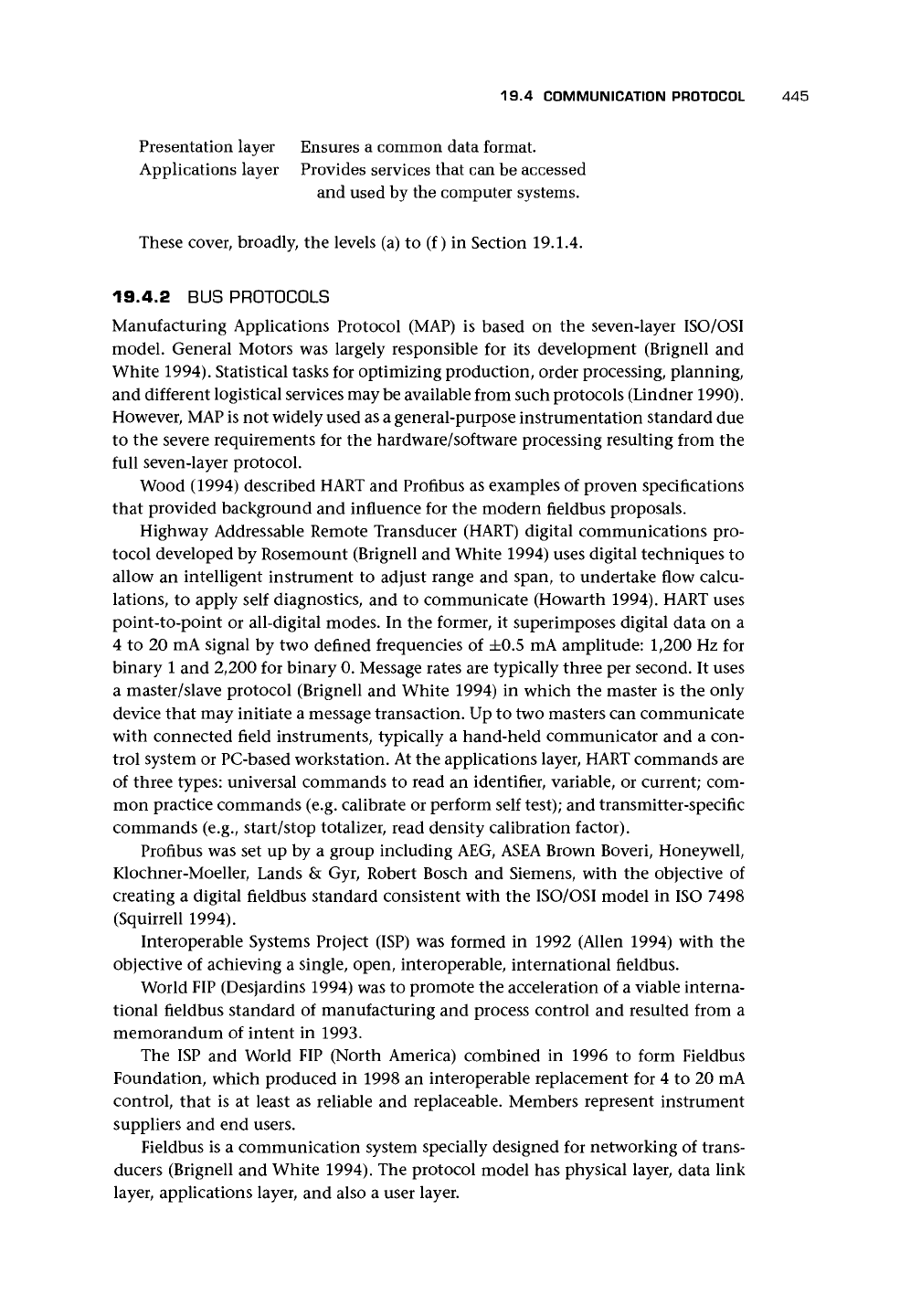
19.4 COMMUNICATION PROTOCOL 445
Presentation layer Ensures a common data format.
Applications layer Provides services that can be accessed
and used by the computer systems.
These cover, broadly, the levels (a) to (f) in Section 19.1.4.
19.4.2 BUS PROTOCOLS
Manufacturing Applications Protocol (MAP) is based on the seven-layer ISO/OSI
model. General Motors was largely responsible for its development (Brignell and
White 1994). Statistical tasks for optimizing production, order processing, planning,
and different logistical services may be available from such protocols (Lindner 1990).
However, MAP is not widely used as a general-purpose instrumentation standard due
to the severe requirements for the hardware/software processing resulting from the
full seven-layer protocol.
Wood (1994) described HART and Profibus as examples of proven specifications
that provided background and influence for the modern fieldbus proposals.
Highway Addressable Remote Transducer (HART) digital communications pro-
tocol developed by Rosemount (Brignell and White 1994) uses digital techniques to
allow an intelligent instrument to adjust range and span, to undertake flow calcu-
lations, to apply self diagnostics, and to communicate (Howarth 1994). HART uses
point-to-point or all-digital modes. In the former, it superimposes digital data on a
4 to 20 mA signal by two defined frequencies of ±0.5 mA amplitude: 1,200 Hz for
binary 1 and 2,200 for binary 0. Message rates are typically three per second. It uses
a master/slave protocol (Brignell and White 1994) in which the master is the only
device that may initiate a message transaction. Up to two masters can communicate
with connected field instruments, typically a hand-held communicator and a con-
trol system or PC-based workstation. At the applications layer, HART commands are
of three types: universal commands to read an identifier, variable, or current; com-
mon practice commands (e.g. calibrate or perform self
test);
and transmitter-specific
commands (e.g., start/stop totalizer, read density calibration factor).
Profibus was set up by a group including AEG, ASEA Brown Boveri, Honeywell,
Klochner-Moeller, Lands & Gyr, Robert Bosch and Siemens, with the objective of
creating a digital fieldbus standard consistent with the ISO/OSI model in ISO 7498
(Squirrell 1994).
Interoperable Systems Project (ISP) was formed in 1992 (Allen 1994) with the
objective of achieving a single, open, interoperable, international fieldbus.
World FIP (Desjardins 1994) was to promote the acceleration of a viable interna-
tional fieldbus standard of manufacturing and process control and resulted from a
memorandum of intent in 1993.
The ISP and World FIP (North America) combined in 1996 to form Fieldbus
Foundation, which produced in 1998 an interoperable replacement for 4 to 20 mA
control, that is at least as reliable and replaceable. Members represent instrument
suppliers and end users.
Fieldbus is a communication system specially designed for networking of trans-
ducers (Brignell and White 1994). The protocol model has physical layer, data link
layer, applications layer, and also a user layer.
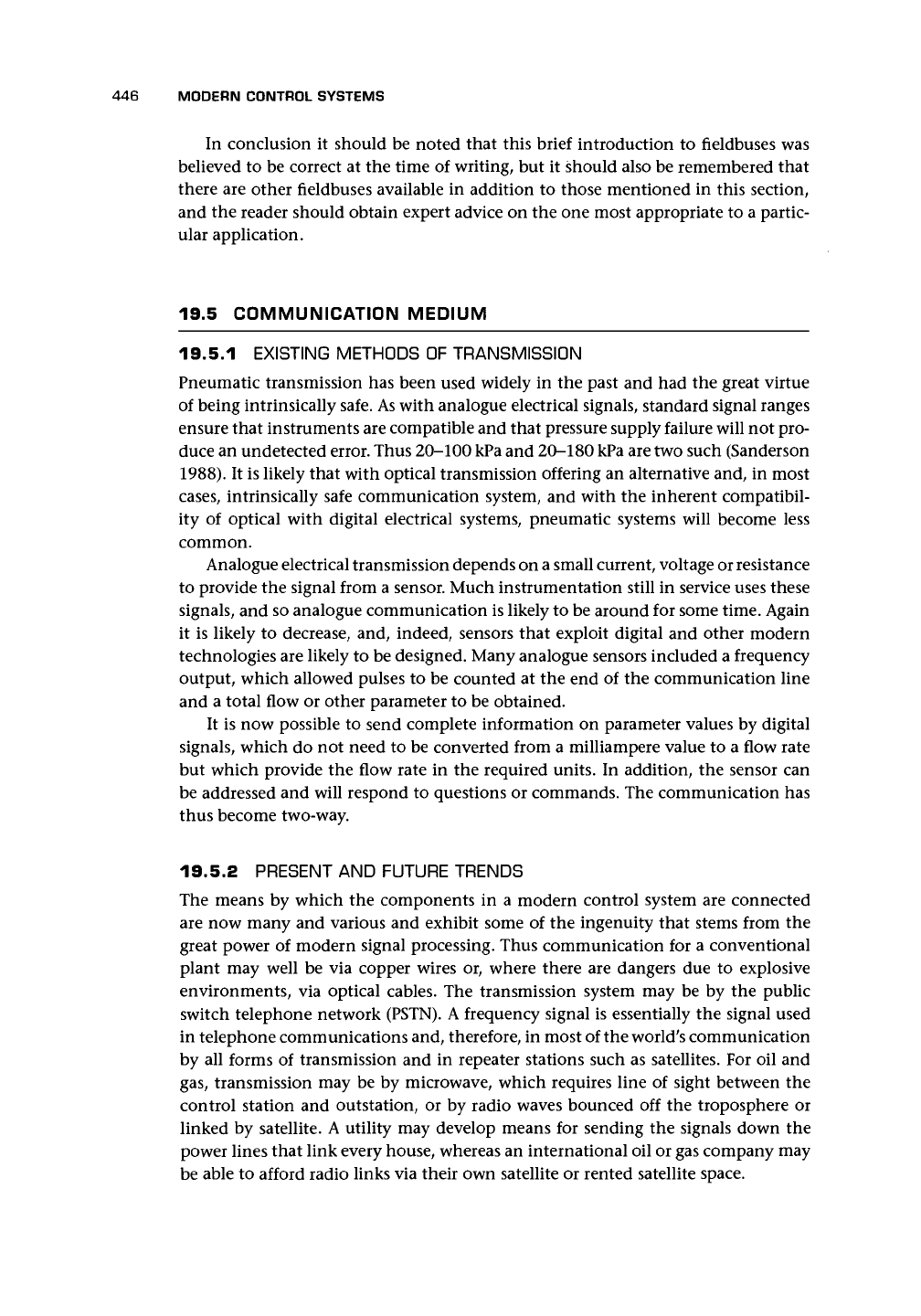
446 MODERN CONTROL SYSTEMS
In conclusion
it
should
be
noted that this brief introduction
to
fieldbuses
was
believed
to be
correct
at the
time
of
writing,
but it
should also
be
remembered that
there
are
other fieldbuses available
in
addition
to
those mentioned
in
this section,
and
the
reader should obtain expert advice
on the one
most appropriate
to a
partic-
ular application.
19.5 COMMUNICATION MEDIUM
19.5.1
EXISTING METHODS
OF
TRANSMISSION
Pneumatic transmission
has
been used widely
in the
past
and had the
great virtue
of being intrinsically safe.
As
with analogue electrical signals, standard signal ranges
ensure that instruments are compatible
and
that pressure supply failure will
not
pro-
duce
an
undetected error. Thus 20-100 kPa
and
20-180 kPa are two such (Sanderson
1988).
It is
likely that with optical transmission offering
an
alternative and,
in
most
cases,
intrinsically safe communication system,
and
with
the
inherent compatibil-
ity
of
optical with digital electrical systems, pneumatic systems will become less
common.
Analogue electrical transmission depends
on
a small current, voltage or resistance
to provide
the
signal from
a
sensor. Much instrumentation still
in
service uses these
signals,
and so
analogue communication
is
likely
to be
around
for
some time. Again
it
is
likely
to
decrease,
and,
indeed, sensors that exploit digital
and
other modern
technologies
are
likely
to be
designed. Many analogue sensors included
a
frequency
output, which allowed pulses
to be
counted
at the end of the
communication line
and
a
total flow
or
other parameter
to be
obtained.
It
is now
possible
to
send complete information
on
parameter values
by
digital
signals, which
do not
need
to be
converted from
a
milliampere value
to a
flow rate
but which provide
the
flow rate
in the
required units.
In
addition,
the
sensor
can
be addressed
and
will respond
to
questions
or
commands.
The
communication
has
thus become two-way.
19.5.2 PRESENT
AND
FUTURE TRENDS
The means
by
which
the
components
in a
modern control system
are
connected
are
now
many
and
various
and
exhibit some
of the
ingenuity that stems from
the
great power
of
modern signal processing. Thus communication
for a
conventional
plant
may
well
be via
copper wires
or,
where there
are
dangers
due to
explosive
environments,
via
optical cables.
The
transmission system
may be by the
public
switch telephone network (PSTN). A frequency signal
is
essentially
the
signal used
in telephone communications and, therefore,
in
most
of
the world's communication
by
all
forms
of
transmission
and in
repeater stations such
as
satellites.
For oil and
gas,
transmission
may be by
microwave, which requires line
of
sight between
the
control station
and
outstation,
or by
radio waves bounced
off the
troposphere
or
linked
by
satellite.
A
utility
may
develop means
for
sending
the
signals down
the
power lines that link every house, whereas
an
international
oil or
gas company may
be able
to
afford radio links
via
their
own
satellite
or
rented satellite space.
